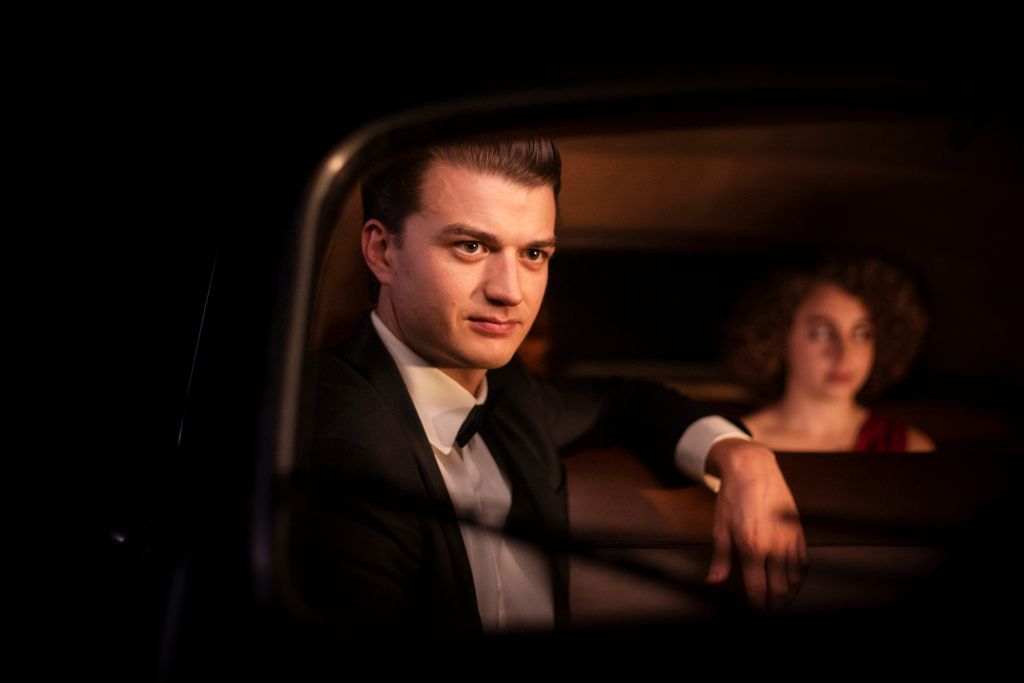Entertainment
L.A. wildfire coverage shows why local TV news matters in a crisis

As the devastating wildfires began to sweep across Los Angeles on Jan. 7, frightened residents were not turning to Netflix.
Local TV news broadcasts were the video go-to for residents seeking immediate information on the crisis that engulfed the region. Anchors and correspondents have spent hours in the field and on the air providing life-saving details about evacuations and damage, along with a generous helping of emotional comfort.
“The performance of local stations has been phenomenal,” said Jonathan Wald, a veteran TV news producer who has worked for NBC News and CNN. “In the face of incredible tragedy, they are knowledgeable and keep their heads as they cover what’s happening in their neighborhoods.”
Traditional TV viewing has been in steady decline during the streaming era, now accounting for just half of all video consumption, according to recent Nielsen data. But even with diminished ratings and profits, TV stations have added hours of news coverage to their lineups and streaming platforms. The trend prepared Los Angeles outlets for a catastrophe that required a sustained flow of up-to-date information.
The availability of local TV news on digital platforms provided horrific yet compelling images of destruction to a global audience well beyond Los Angeles. Wald called the wildfires “the white Bronco chase of natural disasters,” referring to the police pursuit of O.J. Simpson that transfixed a nation of viewers in 1994.
Stations saw viewership double and triple for their news programming during the first week of wildfire coverage, according to Nielsen data, with more than 1 million watching in prime time on Jan. 7. Hundreds of millions of minutes have been streamed across the station’s digital platforms.
Some journalism purists look down their noses at local TV news, which was once defined by stunts, gimmicks, and breezy “happy talk” in the studio.
But in an era when mainstream media have been under attack for perceived bias, viewers still mostly trust local TV news. The Reuters Institute for the Study of Journalism issued a report last year showing that local TV news was trusted by 62% of Americans surveyed, well ahead of any network, cable or digital source.
Long-tenured local TV reporters and anchors develop roots in the area. Their personal stakes were laid bare as the inferno that swept across the region threatened their own families and friends.
“One of the things that makes local news powerful is that the people reporting are experiencing the story themselves,” said Andrew Heyward, a former CBS News president who currently consults local TV stations. “And viewers feel like they know them.”
Elex Michaelson, a veteran anchor at Fox’s KTTV, said years of covering stories and emceeing community events helps journalists build connections with the audience. It gives them credibility when they provide information and comfort in a crisis.
That’s not always easy while covering a disaster in your backyard. Michaelson struggled to stay composed when he learned that Agoura Hills, his childhood neighborhood, was being evacuated.
“That’s when I started to tear up,” Michaelson said in an interview. “When their evacuation orders went out and my sister’s house was a part of it, I thought of her grabbing their new baby and leaving, not knowing if the house was going to be there when they got back.”
For days, Jasmine Viel of CBS station KCAL and her husband Marc Cota-Robles, an Orange County native who reports for Disney-owned KABC, were out on 12- to 14-hour shifts while her mother watched their children in Pasadena. They stared at each other in disbelief in the brief moments they crossed paths at home during the first week of the disaster.
“We couldn’t even talk about it, because we didn’t even know what was going to happen next,” Viel told The Times.
Every local TV reporter covering the wildfires has a story to tell about stepping out of their journalistic role to help residents. Viel found a distraught Pasadena woman who saw flames approaching a coop that housed pet chickens and ducks behind her home on Altadena Drive. Viel’s camera operator John Schreiber, whose wife grew up on a farm, handled the birds as they were removed and rescued.
KTTV’s Gigi Graciette, a Hollywood native who has covered numerous wildfires, makes a point of resetting her live shot every 25 minutes and telling viewers the number of the block she‘s on so they can determine whether they will be affected.
“There is nothing more frustrating than to hear on the news that something is happening in your neighborhood, but you don’t know what street it’s on,” she said.
National cable and broadcast networks have their own reporting teams on the ground covering the wildfires. But many of the images those outlets use come from local stations. CNN took live shots from KABC, KCAL and Spectrum News Los Angeles. NewsNation, the cable network owned by Nexstar Media Group, utilized the parent company’s KTLA for hours of live coverage.
Broadcast networks ABC, CBS and NBC have also relied on their locally owned stations for network coverage of the fire on TV and their streaming news channels.
Providing sustained live coverage online is essential in the age of video on-demand. TV station streams of news programming are widely available for free on such platforms as Amazon’s Prime Video, Tubi, Pluto TV and Roku.
“People don’t want to wait,” said Frank Cicha, executive vice president for Fox Television Stations. “Local television was famous for, ‘We’ll be back later with what you want to see,’ and they were able to get away with it.” Not anymore.
Fox Television Stations’ streaming platform, LiveNOW, provides video from its 29 outlets across the country. KTTV’s fire coverage ran continuously on LiveNow for days, driving a 65% increase in traffic, according to Emily Stone, vice president of digital content for Fox.
“It gave people a chance to watch local, live up-to-the-minute coverage of a story happening in a huge U.S. city that everybody cares about,” Stone said.
Reaching viewers outside of Los Angeles has helped in fundraising efforts for those displaced by the wildfire and prompted other acts of generosity. After KCAL’s Jeff Nguyen interviewed a man whose home was destroyed, the owner of an empty residence in Laguna Beach offered it as temporary shelter.
Graciette told the story of an 81-year-old Navy veteran in Altadena who lost his electric wheelchair in the blaze. Multiple offers came from viewers to replace it. A woman watching in England told Graciette she was inspired to make a donation to a veterans group.

Movie Reviews
Finally Dawn (2025) Movie Review: Fellinie-esque excess and coming-of-age meet the hollowness of Hollywood

You’ve seen this before. A young, unassuming person suddenly gets thrust into the Hollywood limelight as they realize the vanity and hollowness of all the glitter. Saverio Costanzo, who you may know from HBO’s beloved Italian drama “My Brilliant Friend,” is no stranger to the 1950s. “Finalmente l’alba (Finally Dawn)”, which is set in the same period and features an ensemble Hollywood cast, evokes a singular time in Italian movie history when Cinecitta (one of the prominent studios of the time) was known for hosting lavish, sword-and-sandals epics like Ben-Hur.
The young person in question here is Mimosa (Rebecca Antonaci), a doe-eyed movie lover whose love for the medium is quickly established as she, her mother, and a more conventionally attractive older sister Iris (Sofia Panizzi) come out of the latest War movie playing in their local theatre in Rome. As they exit the theatre, discussing the obsession of new-age directors with the futility of the war that they have just suffered, a crew member from Cinecitta spots Iris and invites her to audition for the latest epic about a female pharoah (a sort of Cleopatra parody on first look) played by Josephine (is played by Lily James in the movie). Now, Mimosa just tags along with her sister, but is quickly spotted by Josephine in a corridor and is offered one of the bigger roles in the film.
Now, “Finally Dawn” thereby turns into an endless loop of excess that the American actors and their consequent Italian hosts go on. Much like “La Dolce Vita,” the excess uncovers the hidden hollowness of the world of movie stars that Mimosa so dearly adores from a distance. We quietly follow her footsteps once the shot of the day is captured. However, the film’s more surreal edges keep pushing it further away from making a point.

James’ diva-like rendition of Josphine feels melodramatic to a point where you either feel nothing towards her, or you simply follow along. Her reasons for inviting Mimosa to tag along with them stem from some deep-seated insecurities and personal demons, but the film is never able to establish any of that. Making Josphie feel like a centre-piece that is given more attention than it rightfully needs, even in the movie-within-the-movie scenario.
I mean, it is quite right to establish Mimosa’s moral standpoint, who doesn’t accept being naked for her shot, but then the film also opens up the tragic death of Wilma Montesi — a real-life incident where an extra on a movie set was found dead on the beach; but never does anything about it except using it symbolically. Director Costanzo has said that he wanted to make the movie because of Wilma’s story, and while he is able to draw parallels through Mimosa’s coming-of-age, using Wilma’s story like that felt a bit exploitative to me.
The film also features an ensemble cast, including Joe Keery, Rachel Sennott, Alba Rohrwacher, and Willem Dafoe, but none of them feel like characters who bring something substantial to the table. It also doesn’t help that newcomer Rebecca Antonaci, who has a remarkable screen time, doesn’t evoke the kind of emotional connection the director is going for. Her character, although essential to the film’s proceedings, feels nudged down by the script’s many meandering tendencies.
Eventually, beyond the great production design that quietly brings back the 1950s and some smashing costume work, “Finally Dawn” is unable to elicit anything particularly interesting for the audience to pay heed to. The lion, for instance, is used as a broad metaphor, but much like its existence within the context of the film itself, the metaphor falls flat, and Mimosa’s story; instantly forgettable.
Read More: 20 Best Films from Italian Neorealism
Finally Dawn (2025) Movie Links: IMDb, Rotten Tomatoes, Letterboxd
Finally Dawn (2025) Movie Cast: Lily James, Rebecca Antonaci, Joe Keery, Rachel Sennott, Alba Rohrwacher, Willem Dafoe, Sofia Panizzi
Entertainment
Essay: ‘Love Island USA’ crowned its first Latino couple. Here's why that matters

We won! Or, at least those of us who were rooting for Amaya Espinal and Bryan Arenales to take home the prize on Season 7 of “Love Island USA.”
After a blockbuster season with its fair share of controversy, the 25-year-old nurse from New York City and the 28-year-old accountant, bartender and real estate agent from Boston, respectively, walked out of the villa $100,000 richer and became the first Latino couple to win “Love Island.” In a time when many Latinos in the U.S. are being inundated with threats to our safety and freedom, this example of a mutual, fun and respectful Latino love is an indulgent little triumph for us all.
The dating show became appointment viewing for millions of fans, including myself, with new episodes dropping almost nightly as the show airs in near real time. “Love Island” — which launched in the U.K. in 2015 and has since spawned several international versions — confines single hotties in a Fijian villa, where they must explore romantic connections and couple up with each other to remain on the show. Viewers and cast members known as “islanders” vote regularly to decide which contestants or couples must pack up their swimsuits and go home. As with most reality TV, there’s messiness, drama, silliness and sexiness that keeps viewers glued to their screens, and we clock in for our shift at the island mines with dedication.
Espinal, a self-described “Dominican Cinderella,” entered the villa as a “bombshell,” a cast addition meant to stir things up for the original couples. Meanwhile, her Prince Charming, Arenales, who is Puerto Rican and Guatemalan, came in during the Casa Amor segment of the show, when islanders are separated by gender and introduced to hot new cast members vying for their attention.
The two coupled up several episodes after meeting in Casa Amor, igniting a romance in large part over a shared understanding of their cultures. Being super hot probably didn’t hurt either, but it was seeing Arenales stand up for our sweet Amaya Papaya against a pile-on from his fellow male islanders that sealed the deal — not just for Espinal, but for the viewers, in particular Latinx ones.
Espinal’s rough start on the series reflected the cultural valleys that exist between Latinos and their non-Latino counterparts in the United States, which can generally make for a tricky dating experience. Three of the male contestants she coupled up with expressed discomfort with her personality and bold manner of expressing herself. It started with a blowup with contestant Ace Greene after he vocalized his discomfort with Espinal touching him and using terms of endearment, in particular the word “babe.”
The same issue came up when she coupled up with Austin Shepard and Zak Srakaew, who took issue with Espinal “moving too fast” by acting overly romantic (on a show called “Love Island,” mind you). This was despite her explaining that in Dominican culture terms like “mi vida,” “mi amor” and “babe” are common terms of endearment, and asking if it was OK that she use them. (Both agreed it was fine.)
Espinal certainly lost her cool — in most cases, I would argue, rightfully so — and regularly became emotional, struggling with feeling misunderstood and attacked. Still, she defended herself with confidence and strength from those who seemed intent on painting her as erratic, intense, pushy and aggressive. During a game in which islanders wrote letters to air out any grievances, she offered them a simple option: “I’m just not your cup of tea to be drinkin’, so don’t f—ing drink it.”
It was during that game in which Greene, Shepard and Srakaew went in on Espinal that Arenales stepped in to defend her, explaining what Espinal had long been saying: Those terms of endearment are common in Latino households. “You’re telling her to meet you halfway,” he said. “You gotta meet her halfway too.”
Arenales gallantly stepping up to support Espinal against a social firing squad sparked a flame between the two. Fan votes showed this moment to be a turning point for Espinal, who became a favorite. It doesn’t hurt that her nurturing personality and adorable zaniness make her very easy to root for.
Seeing Arenales voice his appreciation for who she is and understanding her background — and Espinal herself refusing to change parts of her personality that she views as the strengths of an “emotional gangsta” — made their coupling a powerful display of Latino love. Those two crazy kids just get each other!
“This is just a message to everyone out there who’s misunderstood: Nobody should be tamed and there’s always someone out there for you who’s going to love you for you and appreciate all your craziness,” Espinal told host Ariana Madix after their win was announced. “Don’t ever settle for nobody.”
This was an especially lovely and important win after this season was marred by a racism scandal in which two Latina islanders were found to have used racial slurs online and in a podcast.
As much as Espinal may have felt misunderstood, Espinal is not a difficult person. There’s no need to decipher her because it’s not that complicated, regardless of her cultural identity. From everything I saw on the show, she showed a tremendous amount of character and kindness. She just didn’t put up with B.S. from guys who were trying to diminish her, call her irrational and insinuate she was clingy. Amaya Papaya always stood on business.
I love that Espinal found someone who sees and appreciates her in Arenales. And judging by their win, she found that in innumerable people who voted for them as well. But there’s nothing anyone should struggle to understand about her.
Yes, parts of her behavior are informed by her culture — but yelling at a man who is trying to make you seem crazy is a universal experience we should all partake in.
Movie Reviews
‘The Scout’ Review: Modest but Accomplished Debut Brings a New York Location Scout’s Routines to Lovely, Low-Key Life

On paper, Sofia (Mimi Davila), the protagonist of Paula Andrea González-Nasser’s mellow debut The Scout, has an enviable job. She spends her days driving through New York, taking photos of building exteriors, cozy apartments and eclectic shops in service of her director’s vision. Sofia is a location scout, an occupation that conjures romantic images of one’s relationship to space.
The truth is that Sofia’s job can be taxing, and in The Scout, which premiered in June at the Tribeca Film Festival, González-Nasser, who was herself a location scout for six years, crafts a modest portrait of its complicated reality. The director reveals how location scouting involves an emotional deftness, a stultifying deference to a director’s vision and lots of patience. Sofia deploys these tools to broker deals between her team and the people from whom they want things. She must act with the urgency demanded by her bosses and be sensitive to the fact that these locations are homes to real people whose memories live in the furniture and on the walls. Often subsumed by other people’s needs and narratives, Sofia struggles to not become a background character in her own story.
The Scout
The Bottom Line
A discreet and confident debut.
Venue: Tribeca Film Festival (U.S. Narrative Competition)
Cast: Mimi Davila, Rutanya Alda, Max Rosen, Ikechukwu Ufomadu, Sarah Herrman
Director-screenwriter: Paula González-Nasser
1 hour 29 minutes
Working from a screenplay she wrote, Gonzàlez-Nasser structures The Scout around discrete interactions Sofia has throughout the day. The film confidently highlights the delicate relationship between people and their spaces, while also acknowledging the understated harshness of a job that requires you to assess, with a certain degree of remove, one of the more intimate elements of another person’s life. Parts of The Scout, in its contemplative tone and observational style, reminded me of Perfect Days. Like Wim Wenders’ poignant study of a middle-aged janitor’s routines in Tokyo, The Scout could find success in arthouse theaters and on the festival circuit.
When we meet Sofia, she is asleep in her own space — a compact, well-lit apartment somewhere in New York. The room resembles the dwellings of so many young people living in the expensive and bustling city. There’s the starkness of the walls, painted an impersonal white, and the minor touches — a standing fan, a gold framed mirror, a small drawing affixed to the wall — that suggest signs of a real life. Following this moment, the young location scout will almost exclusively occupy the shops and homes of other people.
Each space offers an opportunity for Sofia to remake herself. The transformations are subtle; the location scout tweaks her personality just enough to connect with the person living in the space so that they might be more amenable to letting a random crew of people take it over. Sometimes, as with an older woman (Rutanya Alda) who tells Sofia about her son who moved to London and rarely visits, the interactions are sweet and revelatory. It’s clear that Sofia’s presence — her kind eyes and encouraging responses — doubles as an invitation for lonelier people to share parts of their life with her. Other times, as with the pet shop owner (Matt Barats) who asks her to dinner or a father (Max Rosen) who follows her around the house with an air of menace, the encounters are fraught and a touch scary. Yet rarely does Sofia lose her cool.
The young woman, played with a quiet conviction by Davila (Problemista), navigates each situation with an understanding that her role in these people’s lives is merely temporary. Her approach differs from that of her colleagues, who barge into these homes with no consideration and much fanfare. They appraise each space with a callous indifference toward who lives there, commenting on ugly doors and unimpressive heirlooms.
Other elements of The Scout reinforce our sense of this transient atmosphere. Cinematographer Nicola Newton shoots each location — whether its Sofia’s room or a brownstone in Brooklyn — with the kind of attention reserved for places you know you’ll never return to. A spare score (composed by Dan Arnés) and the familiar melodies of a cityscape (birds chirping, engines running) soundtrack Sofia’s experiences.
Despite their meditative loveliness, low-key projects like The Scout can leave something to be desired in terms of narrative. The lure of a story built on vignettes can shortchange its principal characters and the constellation of supporting ones. As Sofia floats from one home to the next, I wondered about the texture of her life. Gonzàlez-Nasser offers some clues through an interaction between Sofia and her old friend Becca (Otmara Morrero), whose gorgeous apartment has been unexpectedly included on the list of the scout’s locations. Their reunion is brief but laden with the weight of history. Conversations about mutual friends and retired dreams are revealing of Sofia’s aspirations; Becca remarks on how Sofia always wanted to be behind the camera and how she, in a way, is a photographer now. The scout doesn’t completely agree and the ensuing silence suggests a history of compromise.
It also exposes a pattern in Sofia’s earlier interactions, underscoring how much the scout almost disappears into each story. When she finally has a moment of self-assertion, in a quiet moment on the beach, it’s a triumph I wish had come sooner.
-

 Culture1 week ago
Culture1 week agoTry to Match These Snarky Quotations to Their Novels and Stories
-

 News6 days ago
News6 days agoVideo: Trump Compliments President of Liberia on His ‘Beautiful English’
-

 News1 week ago
News1 week agoTexas Flooding Map: See How the Floodwaters Rose Along the Guadalupe River
-
Business1 week ago
Companies keep slashing jobs. How worried should workers be about AI replacing them?
-
Finance1 week ago
Do you really save money on Prime Day?
-

 Technology1 week ago
Technology1 week agoApple’s latest AirPods are already on sale for $99 before Prime Day
-

 News5 days ago
News5 days agoVideo: Clashes After Immigration Raid at California Cannabis Farm
-

 Politics1 week ago
Politics1 week agoJournalist who refused to duck during Trump assassination attempt reflects on Butler rally in new book














